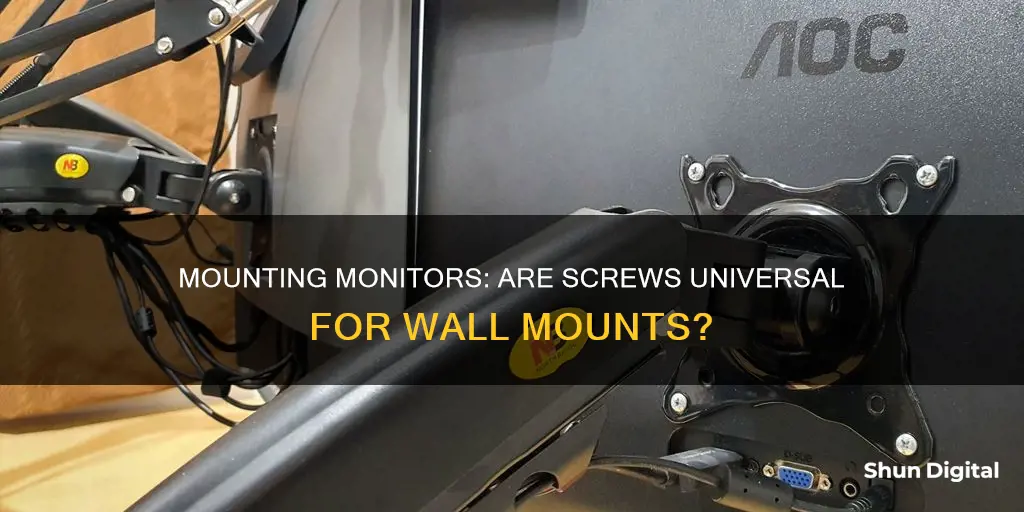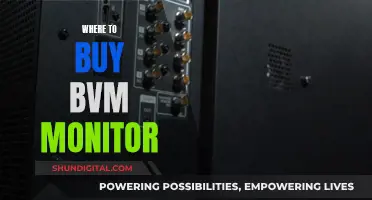
When it comes to monitor wall mounts, one of the most important steps in the installation process is identifying the right screw size for your specific setup. Using the wrong screw size can result in an unstable mount or even damage to your monitor. Most monitor mounts use either VESA screws or non-VESA screws. VESA screws are standardised and will fit most monitors, whereas non-VESA screws are not standardised and may require custom mounts. It is important to refer to the monitor's manual or manufacturer's website to determine the correct screw type and size. Most monitors are mounted using metric M4, M6, or M8 screws, with M6 being the most common.
| Characteristics | Values |
|---|---|
| Common screw sizes | M4, M5, M6, M8 |
| Screw type | VESA screws, non-VESA screws |
| Screw length | 10mm |
| Screw head type | Phillips head, thumb screws, knurled thumbscrews |
| Washers | May be needed for monitors larger than 27 inches |
| Spacer fit | Fits most TVs up to 80 inches |
What You'll Learn

VESA mount screw sizes
When it comes to monitor wall mounts, the VESA screw size is the standard. VESA stands for Video Electronics Standards Association, a group of companies that have set standards for consumer electronics, including the mounting hole patterns on the backs of televisions and monitors.
VESA screws are standardised, meaning they will fit most monitors. The VESA Mounting Standard defines the distance between the mounting holes on the back of a monitor or TV, and it's important to understand how this works before mounting your device. The VESA size is typically expressed in millimeters and given as width x height. For example, a VESA size of 400x200 means the distance between the mounting holes is 400mm across and 200mm high.
The VESA standard classifications are MIS-B, MIS-C, MIS-D, MIS-E, and MIS-F, with MIS-D, MIS-E, and MIS-F being the most common. The screw size will depend on the VESA size of your monitor or TV. Smaller sizes (under 200mm) typically use M4 screws, while M6 screws are commonly used for 200x200 screens, and M8 screws are for larger screens. Most monitors use metric M4, M6, or M8 screws, and the M indicates the outer diameter of the screw in millimetres.
It's important to note that using the wrong screw size can result in an unstable mount or even damage to your monitor. Therefore, it's recommended to refer to the manufacturer's specifications and your monitor's manual to determine the correct screw size and pitch for your specific setup. Additionally, tools like a thread gauge and a caliper can help you accurately measure the screw size, pitch, length, and diameter.
Monitoring Data Usage: Track Device Consumption
You may want to see also

M4, M6, M8 screw types
M4, M6, and M8 screws are standard machine screws used for most monitors. The "M" in their names indicates that they are metric screws, and the number corresponds to the outer diameter of the screw in millimetres. For example, an M4 screw has an outer diameter of 4 millimetres.
M4 screws are also used for smaller monitors, up to 32 inches, and are the smallest of the three screw sizes. They are often used in conjunction with a washer or stand-off, although some monitors may not require these additional components.
M6 screws are the most common size for monitor mounting, with many manufacturers standardising their use. These screws are typically used for monitors ranging from 19 to 27 inches in size, although they may also be found in larger monitors.
M8 screws are less commonly mentioned in the context of monitor mounting. However, they follow the same naming convention as M4 and M6 screws, with an outer diameter of 8 millimetres.
It is important to note that simply measuring the outer diameter of the screw is not sufficient to ensure compatibility. The pitch and length of the screw must also be considered. The pitch refers to the distance between adjacent threads and is typically measured in millimetres. For example, an M6 screw may have a pitch of 1.0, indicating that the distance from one thread to the next is 1.0 millimetre.
When selecting screws for monitor mounting, it is crucial to refer to the manufacturer's specifications and the manual to ensure the correct screw size, pitch, and length are used. Using the wrong screw size can lead to an unstable mount or even damage the monitor.
Taiwan's Utilities: Monitoring Residential Peak Usage?
You may want to see also

Standard metric screw sizes
The ISO metric screw thread is the most commonly used type of general-purpose screw thread worldwide. The "M" designation for metric screws indicates the nominal outer diameter of the screw thread in millimetres. This is also referred to as the "major" diameter. The most common system adhered to is the ISO Metric Screw Thread, where designations like M6x1 signify an M6 screw with a major diameter of 6 mm and a pitch of 1 mm. The M designation indicates that the screw is metric, and the number corresponds to the outer diameter.
Most monitors accept standard machine screws M4, M6, or M8. M6 screws are the most common for monitor mounting. M4 screws are sometimes used for monitors up to 32 inches, while monitors larger than 27 inches usually use M6 screws. The M4, M6, and M8 screw sizes can be approximated in inches as 1/8”, 1/4”, and 1/3”, respectively.
When selecting the correct screw size for your monitor mount, it is important to refer to the manufacturer's specifications and recommendations. Using the wrong screw size can result in an unstable mount or damage to your monitor.
Monitoring Snapchat: A Guide for Parents
You may want to see also

Screw thread and pitch
The thread size and pitch of a screw are important factors to consider when mounting a monitor. Using the wrong screw size or pitch can lead to an unstable mount and even damage your monitor. Therefore, it is crucial to understand these specifications to ensure a secure and safe installation.
Thread size refers to the diameter of the screw, typically denoted by the letter "M" followed by a number. For example, M4, M5, or M6 screws are commonly used for monitors. The number after the "M" indicates the outer diameter of the screw in millimetres.
On the other hand, pitch refers to the distance between the same point on adjacent threads of a screw. It can be referred to as TPI (threads per inch) or simply measured in millimetres. To calculate the pitch, you can count the number of threads in one inch and divide it by the thread diameter. For instance, if the thread diameter is 4 mm and there are 0.7 threads in one millimetre, the pitch would be 0.175 mm.
Most monitor mounts use standard machine screws with metric sizing. The VESA mount pattern, defined by the Video Electronics Standards Association, is commonly used for mounting flat panel displays, monitors, and TVs. VESA screws are standardised and will fit most monitors. The VESA mount pattern is measured in width and height in millimetres, and the screw holes are typically arranged in a square pattern.
It is worth noting that while most manufacturers have standardised on M6 screws for monitor mounting, there may be variations depending on the brand, model, and age of the monitor. Older monitors, especially those manufactured before 2001, may not follow the same standards. Therefore, it is always important to refer to the manufacturer's specifications and manual to determine the correct screw size and pitch for your specific monitor mount.
To measure the screw size and pitch accurately, you can use tools such as a thread gauge and a caliper. A thread gauge helps you identify the exact diameter and thread pitch by matching the screw to the corresponding notch or groove on the gauge. On the other hand, a caliper provides precise measurements of the screw's length and diameter, ensuring you select the appropriate mounting kit.
Smart View: ASUS Monitors' Unique Feature Explained
You may want to see also

Monitor mount types
Monitor mounts are devices that allow you to mount flat-panel TVs and monitors on walls, desks, or ceilings. They are commonly used in home offices, entertainment systems, classrooms, boardrooms, bars, and restaurants. There are several types of monitor mounts available, each offering different features and benefits.
Desk Mounts
Desk mounts are the most common type of monitor mount. They attach to the back of the monitor and clamp onto the edge of a desk, saving space and creating a sleek look. Desk mounts are ideal for those who want a permanent yet flexible mounting solution. They are easy to install and offer a variety of viewing options, including tilt and swivel adjustments.
Wall Mounts
Wall mounts are attached to the wall, freeing up desk space and allowing for a sleek and modern appearance. They are perfect for smaller workspaces or for those who want to create a minimalist setup. Wall mounts typically require a power drill, hammer, and screwdriver for installation.
Ceiling Mounts
Ceiling mounts are less common but can be useful in certain settings such as conference rooms or classrooms. They allow you to suspend the monitor from the ceiling, which is ideal for displaying information to a large group of people. Ceiling mounts save valuable wall and floor space and often include tilt and swivel adjustments for optimizing the viewing angle.
Free-Standing Mounts
Free-standing mounts feature a weighted base that sits securely on the desk, providing stability for the monitor arm. This type of mount is simple and easy to set up, making it a good choice for temporary or short-term solutions.
Clamp Mounts
Clamp mounts, also known as C-clamps or edge clips, attach to the back edge of the desk. They are a more sophisticated and semi-permanent mounting option. Clamp mounts are suitable when the desk edge is too shallow for a grommet mount, offering flexibility and a secure hold.
Grommet Mounts
Grommet mounts are a more permanent solution that provides stability for the monitor arm. They require drilling a hole in the desk for the supporting arm to feed through and secure the base on the ground. This type of mount is ideal when a desk edge is too shallow for a clamp mount.
Upgrading Your Asus Monitor: A Step-by-Step Guide
You may want to see also
Frequently asked questions
Most monitors are mounted using metric M6 screws, but there is no one standard screw size for monitor wall mounts. The most common screw sizes are M4, M6, and M8.
VESA screws are standardised and will fit most monitors. Non-VESA screws are not standardised and may require custom mounts.
You can refer to your monitor's manual or the manufacturer's website to determine the correct screw size. You can also measure the screw holes on your monitor and the corresponding holes on the mount to find the right size.
Using the wrong screw size can result in an unstable mount or even damage to your monitor.







